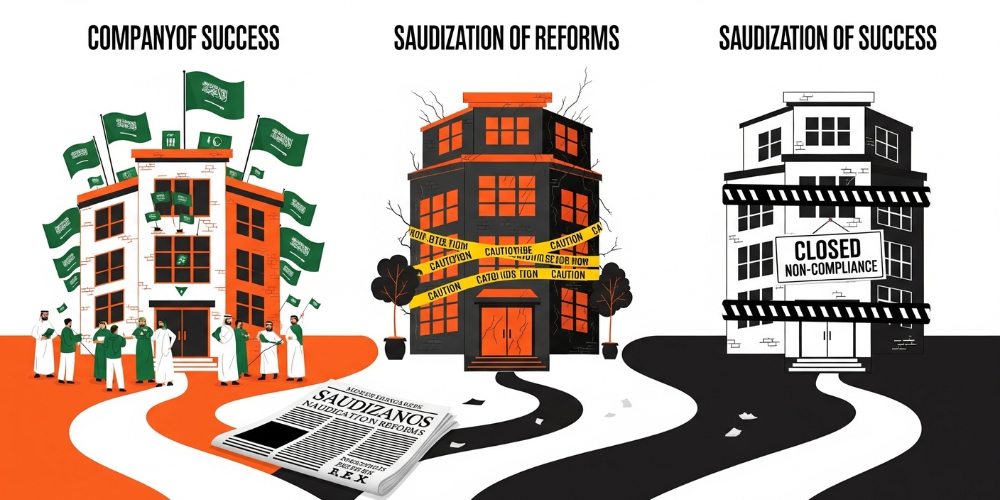What Happens If You Miss Your Nitaqat Targets? Understanding the Risks

TL;DR
- The Nitaqat system ranks companies by how many Saudi nationals they hire.
- Falling into Red or Yellow status can block work visas and freeze hiring.
- Missed targets lead to penalties, permit suspensions, and audits.
- Use tools like the Nitaqat calculator and status checker to stay compliant.
- Strategic hiring and workforce segmentation help meet Saudization quotas.
In Saudi Arabia, Nitaqat targets aren’t just a box to check. They directly impact how your business runs. If you fall short, you could lose the ability to hire expats, renew work visas, or access key government services. Drop into Red or Yellow Nitaqat status, and suddenly your HR operations can grind to a halt. That’s the real impact of the Nitaqat system in Saudi Arabia. It’s not just policy, it’s operational risk.
Here’s the upside: staying on track with the Nitaqat Saudization program is totally doable. It starts with knowing where your company fits, using tools like the Nitaqat calculator to check your current standing, and making sure your hiring plans align with national quotas. This blog will walk through how the Nitaqat system actually works, why it’s important, and what can happen if your company slips behind.
NITAQAT COMPLIANCE STRESS METER
Do you check your Nitaqat status monthly?
What Is Nitaqat System in Saudi Arabia?

The Nitaqat system is a Saudization policy introduced by the Ministry of Labour Nitaqat framework in 2011. Its goal is to increase the employment of Saudi nationals in the private sector. Under this system, companies are grouped into categories such as Platinum, Green (High, Medium, Low), Yellow, and Red, based on how many Saudi citizens they employ relative to their total workforce.
Your Nitaqat status depends on how many Saudi nationals you employ. The more you hire, the better your standing. Companies in Platinum or High Green often get quicker approvals and extra perks. But if you slip into Yellow or Red, things can slow down, especially when it comes to renewing or issuing work visas.
If your company has more than 100 employees, you’re generally expected to meet a Saudization rate of around 30%. That said, the exact requirement can shift depending on your industry and the type of license you hold.
Why Do Nitaqat Targets Matter for Employers?

If your Nitaqat status drops, the Ministry of Labour Nitaqat system can block your ability to:
- Renew iqamas (residency permits) for foreign workers
- Issue new work visas
- Transfer sponsorships
- Access government contracts or bidding opportunities
Worse still, you may be subject to penalties or delays that damage your reputation with both regulators and clients. That’s why smart companies regularly perform a Nitaqat status check to stay ahead.
You can use the Nitaqat calculator available on the Ministry of Human Resources and Social Development (MHRSD) portal to simulate how hiring or terminating certain staff will affect your status.
What Happens If You Miss Your Nitaqat Targets?

Here’s what you might be dealing with if your numbers fall short:
- Blocked services: Your company won’t be able to issue new work visas or renew Iqamas.
- Restricted mobility: You cannot transfer employees between branches or companies.
- Fines and sanctions: The government may impose monetary penalties or suspend access to public procurement systems.
- Increased scrutiny: Your hiring decisions may be audited, and you’ll be under pressure to quickly improve your Nitaqat status.
For example, companies in the Red category are barred from renewing any foreign workers’ permits and must meet Saudization requirements before being allowed to resume basic HR functions. Companies in Yellow may only renew permits for select roles and for limited periods.
Starting May 2024, Saudi Arabia’s Ministry of Human Resources and Social Development expects consulting firms to ensure that at least 40 percent of key roles, such as financial, business, cybersecurity, and project management, are filled by Saudi nationals.
Examples of Companies Affected

Real-world cases show that missing Nitaqat targets can shut down operations, sometimes literally:
- Over 200,000 firms closed in 2013–14 for failing to comply. Approximately 36,951 remained in Red and Yellow Nitaqat status, affecting over half a million expatriate workers.
- In the retail sector, Saudization requirements of up to 70% triggered forced restructuring. Several outlets were either fined or denied new branch licenses.
- A recent legal advisory noted that even Platinum-rated companies faced penalties for improper WPS or reporting violations, showing that compliance isn’t just about numbers.
How to Avoid Missing Your Nitaqat Targets

Staying on track with Nitaqat targets requires planning and proactive tools:
- Perform regular Nitaqat status checks via the MHRSD or Qiwa portals to monitor your Nitaqat status and catch issues early.
- Use the Nitaqat calculator to simulate hiring changes and forecast your Saudization percentage.
- Segment workforce planning by company size. Enterprise quotas vary depending on whether you’re micro (<5), small, medium, or large (50+ employees); thresholds under the Nitaqat system in Saudi Arabia.
- Leverage Saudization support programs like HRDF, Tamheer, and Hafiz. These government initiatives help subsidize training and reduce onboarding costs.
- Integrate HR systems with compliance checks for payroll, WPS, and workforce data reporting to keep everything aligned with the Ministry of Labour Nitaqat standards.
- Respond swiftly to dips in status. Yellow status triggers limited permit renewals, so make immediate hires or redeploy Saudis to critical roles.
Decode the Red Zone: What Went Wrong?
Company X is suddenly in the Red Zone. Revenue is down. What triggered the Nitaqat penalty?
Conclusion
Missing Nitaqat targets is more than a red tape issue. It can freeze operations, cut off visa renewals, reduce access to government contracts, and even shut down businesses. Yet, with regular nitaqat status checks, smart use of the nitaqat calculator, and targeted workforce planning (segmented by company size), you can protect your status and stay in business. Tools, incentives, and legal guidance are all in place; use them proactively, and you’ll transform the Nitaqat system in Saudi Arabia from a regulatory hurdle into a business edge.
Frequently Asked Questions
Penalties vary based on the violation, starting from SAR 2,000 and increasing depending on company size and frequency of non‑compliance. Services like visa issuance, iqama renewals, and licensing may also be suspended.
Yes. For Yellow, hiring enough Saudis can move your company back to Green status and restore services. Red status requires full compliance before you can resume visa renewals or government interactions.
The Nitaqat system updates your company’s classification in real time based on activities like iqama issuance and payroll. Formal evaluations are posted quarterly on the MHRSD portal, but monthly nitaqat status checks are highly recommended.
Yes. Micro (<5), small, medium, and large enterprises all have different Saudization targets. For example, firms with 50+ employees may need at least 30% Saudization, with quotas increasing for certain sectors.






